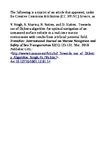Towards use of Dijkstra Algorithm for Optimal Navigation of an Unmanned Surface Vehicle in a Real-Time Marine Environment with Results from Artificial Potential Field
| dc.contributor.author | Singh, Y | |
| dc.contributor.author | sharma, sanjay | |
| dc.contributor.author | Sutton, R | |
| dc.contributor.author | Hatton, Daniel | |
| dc.date.accessioned | 2018-04-12T18:30:16Z | |
| dc.date.issued | 2018-03-29 | |
| dc.identifier.issn | 2083-6473 | |
| dc.identifier.issn | 2083-6481 | |
| dc.identifier.uri | http://hdl.handle.net/10026.1/11268 | |
| dc.description.abstract |
The growing need of ocean surveying and exploration for scientific and industrial application has led to the requirement of routing strategies for ocean vehicles which are optimal in nature. Most of the optimal path planning for marine vehicles had been conducted offline in a self‐made environment. This paper takes into account a practical marine environment, i.e. Portsmouth Harbour, for finding an optimal path in terms of computational time between source and end points on a real time map for an USV. The current study makes use of a grid map generated from original and uses a Dijkstra algorithm to find the shortest path for a single USV. In order to benchmark the study, a path planning study using a well‐known local path planning method artificial path planning (APF) has been conducted in a real time marine environment and effectiveness is measured in terms of path length and computational time. | |
| dc.format.extent | 125-131 | |
| dc.language | en | |
| dc.language.iso | en | |
| dc.publisher | Gdynia Maritime University | |
| dc.title | Towards use of Dijkstra Algorithm for Optimal Navigation of an Unmanned Surface Vehicle in a Real-Time Marine Environment with Results from Artificial Potential Field | |
| dc.type | journal-article | |
| plymouth.issue | 1 | |
| plymouth.volume | 12 | |
| plymouth.publisher-url | http://www.transnav.eu/Article2_Towards_use_of_Dijkstra_Algorithm_Singh,45,795.html | |
| plymouth.publication-status | Published | |
| plymouth.journal | TransNav: International Journal on Marine Navigation and Safety of Sea Transportation | |
| dc.identifier.doi | 10.12716/1001.12.01.14 | |
| plymouth.organisational-group | /Plymouth | |
| plymouth.organisational-group | /Plymouth/Faculty of Science and Engineering | |
| plymouth.organisational-group | /Plymouth/Faculty of Science and Engineering/School of Engineering, Computing and Mathematics | |
| plymouth.organisational-group | /Plymouth/REF 2021 Researchers by UoA | |
| plymouth.organisational-group | /Plymouth/REF 2021 Researchers by UoA/UoA12 Engineering | |
| plymouth.organisational-group | /Plymouth/Research Groups | |
| plymouth.organisational-group | /Plymouth/Research Groups/Marine Institute | |
| plymouth.organisational-group | /Plymouth/Users by role | |
| plymouth.organisational-group | /Plymouth/Users by role/Academics | |
| dcterms.dateAccepted | 2016-11-16 | |
| dc.identifier.eissn | 2083-6481 | |
| dc.rights.embargoperiod | No embargo | |
| rioxxterms.versionofrecord | 10.12716/1001.12.01.14 | |
| rioxxterms.licenseref.uri | http://www.rioxx.net/licenses/all-rights-reserved | |
| rioxxterms.licenseref.startdate | 2018-03-29 | |
| rioxxterms.type | Journal Article/Review |


